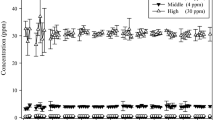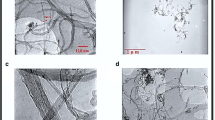Abstract
Inhalation exposure of male rats at three dose levels (4.2, 21, 62 mol/L) ton-heptane vapor caused a dose-dependent brain and body solvent burden, which increased during two weeks of exposure. Initial neurochemical effects included reduced RNA concentration and increased NADPH-diaphorase in brain at the lowest dose. Increased proteolysis was detected in the cerebral samples in the second week at all doses, and the NADPH-diaphorase returned to the control range. Brain RNA content tended to be larger than in the controls. All biochemical effects were abolished after two weeks of withdrawal from the two-week exposure, with the exception of reduced glutathione at the lowest dose. None of the rats presented clinical signs of neuropathy, which indicates that heptane and its metabolites do not share the specific neurotoxicity of hexane and its metabolites.
Similar content being viewed by others
References
Bruckner, J. V., and R. G. Peterson: Toxicology of aliphatic and aromatic hydrocarbons. In C. W. Sharp, and M. L. Brehm (eds.): Review of inhalants: Euphoria to dysfunction. p. 124. Bethesda: National Institute on Drug Abuse Research (1977).
Elovaara, E., H. Savolainen, M. G. Parkki, A. Aitio, and H. Vainio: Neurochemical effects of 2,3,7,8-tetrachlorodibenzo-p-dioxin in Wistar and Gunn rats. Res. Commun. Chem. Path. Pharmacol.18, 487 (1977).
Frommer, U., V. Ullrich, H. Staudinger, and S. Orrenius: The monooxygenation ofn-heptane by rat liver microcomes. Biochem. Biophys. Acta280, 487 (1972).
Gerarde, H. W.: The aliphatic (open chain, acyclic) hydrocarbons. In F. A. Patty, D. W. Fassett, and D. D. Irish (eds.): Industrial hygiene and toxicology. Vol. II, Toxicology, p. 1195. New York: Interscience Publisher (1963).
Haydon, D. A., B. M. Hendry, S. R. Levinson, and J. Requena: Anaesthesia by then-alkanes: A comparative study of nerve impulse blockage and the properties of black lipid bilayer membranes. Biochem. Biophys. Acta470, 17 (1977).
Hissin, P. J., and R. A. Hilf: A fluorometric method for the determination of oxidized and reduced glutathione in tissues. Anal. Biochem.74, 214 (1976).
Kubinyi, H.: Lipophilicity and biological activity. Drug transport and drug distribution in model systems and in biological systems. Arzneimittel-Forsch. (Drug Res.)29, 1067 (1979).
Lawler, G. C., W.-A. Loong, and J. L. Laseter: Accumulation of saturated hydrocarbons in tissues of petroleum-exposed mallard ducks (Anas platyrhyncos). Environ. Sci. Technol.12, 47 (1978).
Marks, N., F. Stern, and A. Lajtha: Changes in proteolytic enzymes and proteins during maturation of the brain. Brain Res.86, 307 (1975).
Marshall, M. J., and M. Worsfold: Superoxide dismutase: A direct, continuous linear assay using the oxygen electrode. Anal. Biochem.86, 561 (1978).
Morimoto, H., P. A. Ferchmin, and E. L. Bennett: Spectrophotometric analysis of RNA and DNA using cetyltrimethylammonium bromide. Anal. Biochem.62, 436 (1974).
Parnas, I., and D. Bowling: Killing of single neurons by intracellular injection of proteolytic enzymes. Nature270, 626 (1977).
Perbellini, L., D. De Grandis, F. Semenzato, N. Rizzuto, and A. Simonati: An experimental study on the neurotoxicity ofn-hexane metabolites: Hexanol-1 and hexanol-2. Toxicol. Appl. Pharmacol.46, 421 (1978).
Savolainen, H.: Some aspects of the mechanisms by which industrial solvents produce neurotoxic effects. Chem.-biol. Interact.18, 1 (1977).
Savolainen, H., and P. Pfäffli: Effects of long-term turpentine inhalation on rat brain protein metabolism. Chem.-biol. Interact.21, 271 (1978).
Spencer, P. S., M. C. Bischoff, and H. H. Schaumburg: On the specific molecular configuration of neurotoxic aliphatic hexacarbon compounds causing central-peripheral distal axanopathy. Toxicol. Appl. Pharmacol.44, 17 (1978).
Spencer, P. S., and H. H. Schaumburg: Neurotoxic properties of certain aliphatic hexacarbons. Proc. Roy. Soc. Med.70, 37 (1977).
Szaro, R. C., M. P. Dieter, and G. H. Heinz: Effects of chronic ingestion of South Lousiana crude oil on mallard ducklings. Environ. Res.17, 426 (1978).
Verschueren, K.: Handbook of environmental data on organic chemicals. New York: Van Nostrand Reinhold (1977).
Author information
Authors and Affiliations
Rights and permissions
About this article
Cite this article
Savolainen, H., Pfäffli, P. Neurochemical effects on rats ofn-heptane inhalation exposure. Arch. Environ. Contam. Toxicol. 9, 727–732 (1980). https://doi.org/10.1007/BF01055547
Received:
Accepted:
Issue Date:
DOI: https://doi.org/10.1007/BF01055547




